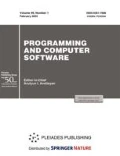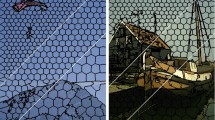Abstract
This paper describes a new method for medical data segmentation based on superpixel propagation. The proposed method is a modification of the classical region growing algorithm and partly inherits the concept of octrees. The key difference of the proposed approach is the transition to the superpixel domain, as well as more flexible conditions for adding neighbor superpixels to the region. The region formation algorithm checks superpixels for compliance with some homogeneity criteria. First, the average intensity of superpixels is compared with the intensity of a resulting region. Second, each pixel on the edges and diagonals of a superpixel is compared with a threshold value. An important feature of the proposed method is the dynamically changing (floating) size of superpixels. The resulting region is formed by constructing a spline based on the points of intersection among the superpixels external to the region. To test the accuracy of the method, we use the MRI images of the left ventricle obtained at the University of York and MRI images of brain tumors obtained at the Southern Medical University. To demonstrate the performance of our method, a set of high-resolution synthetic images was additionally created. As an accuracy estimation metric, we use the Dice similarity coefficient (DSC). For the proposed method, it corresponds to 0.93 ± 0.03 and 0.89 ± 0.07 for the left ventricle and tumor segmentation, respectively. It is demonstrated that a step-by-step reduction in the size of a superpixel can significantly speed up the method without loss of accuracy.














Similar content being viewed by others
REFERENCES
Huang, X. and Tsechpenakis, G., Medical image segmentation, Adv. Mater. Res., 2009, no. 1, pp. 1–35.
Rogowska, J., Overview and fundamentals of medical image segmentation, Handbook of Medical Imaging, Elsevier, 2000, pp. 69–85.
Pham, D.L., Xu, C., and Prince, J.L., Current methods in medical image segmentation, Annu. Rev. Biomed. Eng., 2000, vol. 2, no. 1, pp. 315–337.
Kang, H.C., Lee, J., and Shin, J., Automatic four-chamber segmentation using level-set method and split energy function, Healthcare Inf. Res., 2016, vol. 22, no. 4, p. 285.
Soliman, A., et al., Accurate lungs segmentation on CT chest images by adaptive appearance-guided shape modeling, IEEE Trans. Med. Imaging, 2017, vol. 36, no. 1, pp. 263–276.
Oktay, O. et al., Anatomically constrained neural networks (ACNNs): Application to cardiac image enhancement and segmentation, IEEE Trans. Med. Imaging, 2018, vol. 37, no. 2, pp. 384–395.
Pereira, S. et al., Brain tumor segmentation using convolutional neural networks in MRI images, IEEE Trans. Med. Imaging, 2016, vol. 35, no. 5, pp. 1240–1251.
Kamnitsas, K. et al., Efficient multi-scale 3D CNN with fully connected CRF for accurate brain lesion segmentation, Med. Image Anal., 2016, vol. 36, pp. 61–78.
Litjens, G. et al., A survey on deep learning in medical image analysis, Med. Image Anal., 2017, vol. 42, pp. 60–88.
Danilov, V.V. et al., Catheter detection and segmentation in volumetric ultrasound using SVM and GLCM, IEEE SciVis Contest, 2018, vol. 10, no. 4, pp. 30–39.
Danilov, V.V. et al., Segmentation algorithm based on square blocks propagation, Proc. 29th Int. Conf. Computer Graphics and Vision, Galaktionov, V. et al., Eds., 2019, pp. 148–154.
Ballard, D.H. and Brown, C.M., Computer Vision, Prentice Hall, 1982.
Adams, R. and Bischof, L., Seeded region growing, IEEE Trans. Pattern Anal. Mach. Intell., 1994, vol. 16, no. 6, pp. 641–647.
Tang, J., A color image segmentation algorithm based on region growing, Proc. 2nd Int. Conf. Computer Engineering and Technology, 2010, vol. 6, pp. 634–637.
Park, J.G. and Lee, C., Skull stripping based on region growing for magnetic resonance brain images, Neuroimage, 2009, vol. 47, no. 4, pp. 1394–1407.
Chiverton, J. et al., Statistical morphological skull stripping of adult and infant MRI data, Comput. Biol. Med., 2007, vol. 37, no. 3, pp. 342–357.
Roy, S. and Maji, P., A simple skull stripping algorithm for brain MRI, Proc. 8th Int. Conf. Advances in Pattern Recognition (ICAPR), 2015, pp. 1–6.
Isa, N.A.M. et al., Automatic detection of breast tumours from ultrasound images using the modified seed based region growing technique, Lect. Notes Comput. Sci. (including Lect. Notes Artif. Intell. and Lect. Notes Bioinf.), 2005, vol. 3682 LNAI, pp. 138–144.
Dehmeshki, J. et al., Segmentation of pulmonary nodules in thoracic CT scans: A region growing approach, IEEE Trans. Med. Imaging, 2008, vol. 27, no. 4, pp. 467–480.
Crommelinck, S. et al., SLIC superpixels for object delineation UAV data, ISPRS Ann. Photogramm., Remote Sens. Spat. Inf. Sci., 2017, vol. 4, no. 2W3, pp. 9–16.
Csillik, O., Fast segmentation and classification of very high resolution remote sensing data using SLIC superpixels, Remote Sens., 2017, vol. 9, no. 3, p. 243.
Duong, T.H. and Hoberock, L.L., DUHO image segmentation based on unseeded region growing on superpixels, Proc. IEEE 8th Annu. Computing and Communication Workshop and Conf. (CCWC), 2018, pp. 558–563.
Saxen, F. and Al-Hamadi, A., Superpixels for skin segmentation, Proc. Workshop Farbbildeerarbeitung, 2014, pp. 153–159.
Ren, X. and Malik, J., Learning a classification model for segmentation, Proc. 9th IEEE Int. Conf. Computer Vision, 2003, vol. 2, p. 10.
Achanta, R. et al., SLIC superpixels compared to state-of-the-art superpixel methods, IEEE Trans. Pattern Anal. Mach. Intell., 2012, vol. 34, no. 11, pp. 2274–2282.
Andreopoulos, A. and Tsotsos, J.K., Efficient and generalizable statistical models of shape and appearance for analysis of cardiac MRI, Med. Image Anal., 2008, vol. 12, no. 3, pp. 335–357.
Cheng J., et al., Enhanced performance of brain tumor classification via tumor region augmentation and partition, PLoS One, Zhang, D., Ed., 2015, vol. 10, no. 10.
Cheng J., et al., Retrieval of brain tumors by adaptive spatial pooling and fisher vector representation, PLoS One, 2016, vol. 11, no. 6.
Wang L., et al., Left Ventricle: Fully automated segmentation based on spatiotemporal continuity and myocardium information in cine cardiac magnetic resonance imaging (LV-FAST), BioMed Res. Int., 2015, vol. 2015, pp. 1–9.
Funding
This work was carried out as part of the “Science” state task no. FFSWW-2020-0014, “Development of the technology for robotic multiparametric tomography based on big data processing and machine learning methods for studying promising composite materials.”
Author information
Authors and Affiliations
Corresponding authors
Additional information
Translated by Yu. Kornienko
Rights and permissions
About this article
Cite this article
Danilov, V.V., Gerget, O.M., Skirnevskiy, I.P. et al. Segmentation Based on Propagation of Dynamically Changing Superpixels. Program Comput Soft 46, 195–206 (2020). https://doi.org/10.1134/S0361768820030044
Received:
Revised:
Accepted:
Published:
Issue Date:
DOI: https://doi.org/10.1134/S0361768820030044




